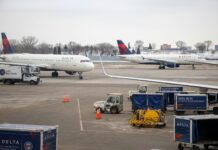As Winter Storm Approaches Iowa: Brace for Blizzard Conditions
With winter storm warnings looming over more than 60 counties in Iowa, residents are advised to prepare for blizzard conditions that could hit the region starting tomorrow night and lasting through Wednesday afternoon. National Weather Service meteorologist Brooke Hagenhoff has issued a cautionary alert, indicating the transition from rain to snow as temperatures plummet, coupled with strong wind gusts exceeding 50 miles per hour.
Impending Blizzard Threat
As the cold front sweeps through the state, the intensifying wind speeds are expected to usher in blizzard-like conditions, posing potential hazards for commuters and residents alike. The looming threat of poor visibility, icy roadways, and drifting snow has prompted officials to issue a Winter Storm Watch, urging caution and preparedness in the face of the impending weather event. Hagenhoff stresses the importance of staying informed about road conditions and exercising prudence while venturing outdoors during the storm’s peak.
Precautionary Measures
While the predicted snowfall amounts are relatively modest, around two inches, the primary concern remains the adverse impact of high winds on visibility and road safety. Hagenhoff advises residents to stay vigilant and exercise caution when navigating through potentially hazardous road conditions. With uncertainties surrounding the duration of blowing snow post-snowfall, it is crucial for individuals to prioritize safety and stay updated on evolving weather conditions to mitigate risks associated with the impending blizzard.
In light of the imminent storm, it is imperative for Iowans to take proactive measures and prepare for the adverse weather conditions that lie ahead. By staying informed, exercising caution, and prioritizing safety, residents can navigate through the winter storm with resilience and preparedness. As the state braces for the impending blizzard, vigilance and community support will be key in ensuring the safety and well-being of all individuals residing in the affected regions.









